Winter Pet Safety
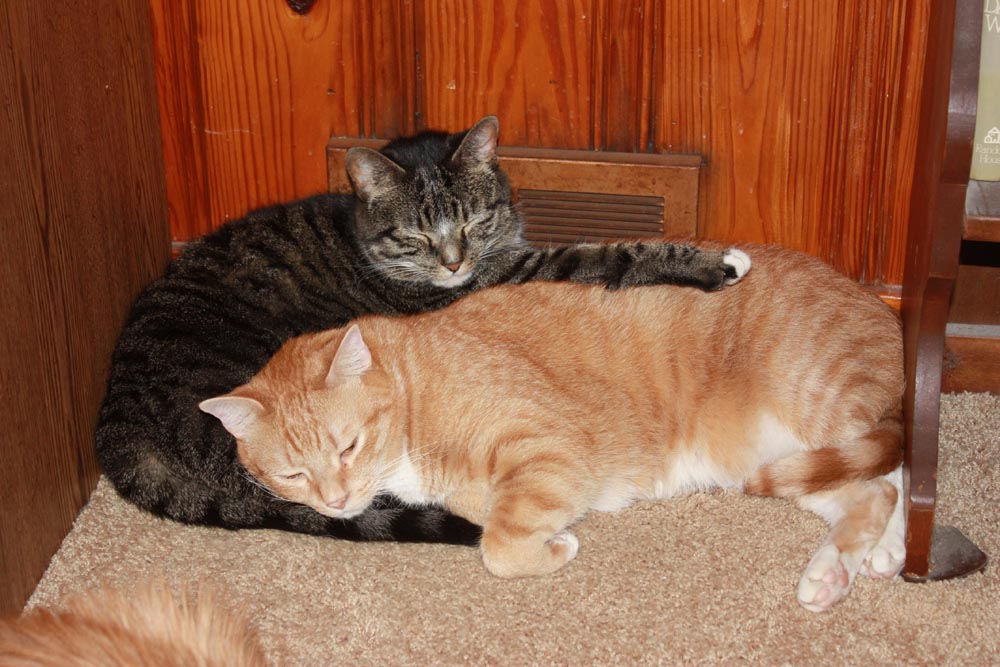
by Karen Sable, Guest Columnist
Winter is upon us and, while Western Pennsylvania has so far been spared any brutally cold weather or major blizzards, we know our luck can’t last, and that another “Snowmaggedon” could be just around the corner. While the holidays have passed, the winter season itself requires some common sense precautions to help keep our furry family members healthy and safe.
Not all pets are “winter hardy”
It’s an unfortunate misconception that cats and dogs are equipped to handle the cold weather because they have fur. The truth is, unless your pet is well adapted to living outdoors, the cold weather can be just as hard on them as it is on us. If your pet normally only leaves the comfort of your home just long enough for a walk or some play time, they are not adapted to spending extended periods of time outdoors, and can become victims of cold injuries just as easily as we can.
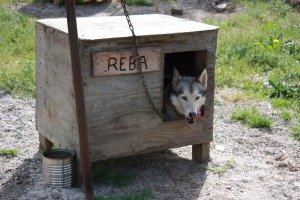
A couple of years ago I was lucky enough to spend some time exploring Alaska, and even trekked up across the Arctic Circle. As you might imagine, dog sledding is a common activity throughout the state, and I was able to visit a couple of the kennels that breed and train dogs for races such as the Iditarod. I was initially rather shocked when I saw that all of the dogs are kept outdoors, often in frigid weather.
While that’s certainly very different from what I would normally consider humane, it is a very different culture there, and the dogs are working animals who do adapt to the conditions. It was obvious from their interactions with the dogs that the owners did love them, and they do take certain precautions, such as providing adequate enclosures the dogs can get into to shield them from the wind and which are elevated above the ground. They also feed them specially blended food that is high in calories and heated to make kind of a warm porridge. Even during a long distance race, the mushers pack a small camping stove which they use to warm their dogs’ food. Most of them also put booties on their dogs’ feet, or use a special wax (Musher’s Secret Paw Wax) to protect their feet from the snow and ice. So even for animals who are bred for life in the cold outdoors and are acclimated to harsh conditions, certain precautions are needed to ensure their health and safety.
For those of us with pets who are far more accustomed to snuggling under the covers with us than to braving the cold, it is extremely important that we take precautions during the winter to keep them healthy, and also that we know what to do in the event that they do become the victim of a cold injury, such as frostbite or hypothermia.
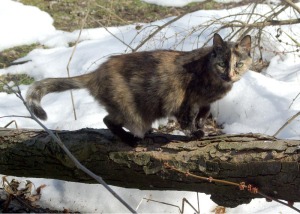
Minimize outdoor time in cold weather
Obviously the best thing you can do for your pet when the temperature drops is to keep them inside. But if you do allow them outdoors, try to minimize the amount of time they are exposed to the elements. Some animals just by their size don’t do as well in the cold or snow as others. For example, cats and small dogs that essentially have to wade through the snow are less able to tolerate the elements than, say, a Great Dane whose stomach isn’t dragging in the snow when he walks. Likewise, short-haired animals can’t handle the cold as well as those with long or thick fur.
Additionally, your pet’s age and overall health will impact their ability to tolerate cold weather. The very young animals, and the seniors, are more vulnerable to the cold. Likewise, pets with diabetes, endocrine diseases , and many other medical conditions are less able to regulate their own body temperature, and are therefore less able to tolerate exposure to the cold. If your pet has any type of medical condition, it is advisable that you talk to your veterinarian about whether the condition may affect their ability to handle the cold, and what you should do to avoid any problems.
Careful with heat sources indoors and out
Those of us who have cats know that they are very skilled at finding sources of warmth. A laundry basket of clothes fresh from the dryer attracts them like a magnet. If you have forced air heat vents or a fireplace, you know that your cats will claim those spaces as their own. I wondered why, even after getting a new furnace, my house still seemed chilly. Then I realized that my cats had found all of the furnace vents, and were sleeping against them, blocking the flow of warm air to me. They are all nice and toasty, but I have to wear a sweater in the house!
- Warm car engines Because they will seek out places to stay warm, you have to be especially careful if you do allow your cats outside, or if you have ferals or strays near your home or where you park for work or shopping. Every winter there are cases where cats are seriously injured or killed because they climbed up into the warm engine block of a vehicle, and then were caught in the moving engine parts when it was started. While your neighbors may think you’re a bit crazy, it’s always a good idea to rap loudly on the hood of your car, or even blow your horn, before starting the engine. You just may see a very startled cat scurry out from underneath!
- Protected areas outdoors Dogs and cats may also seek shelter in dumpsters, window wells, cellars, sheds, under porches, or even in snow banks, and can become trapped. Be sure to keep an eye on your pets if you do let them outside, and monitor any spaces around your home that could be an inviting shelter for an animal.
- Fireplaces If you light your fireplace or use a space heater, the heat will attract your pets. Make sure your fireplace has a secure screen around it to keep any curious paws or wagging tails from being burned, and be sure to place any space heater where your pets can’t come in direct contact with the heating element, or possibly knock the heater over and cause a fire.
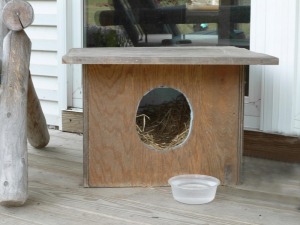
Build an outdoor shelter
If you absolutely have to leave your pet outside for any extended period or if, like me, you care for strays and ferals, a proper dog house or other enclosure is essential to help them survive the elements. You can purchase a good, insulated pet house, or you can even build your own fairly easily. An on-line search will turn up plans for a variety of different outdoor enclosures.
Whether you buy one or make your own, an important step to take is to add a thick bed of straw inside the enclosure. Straw is far better than blankets, towels, carpets, or even fabric pet beds, since it is a good insulator and does not hold in the moisture.
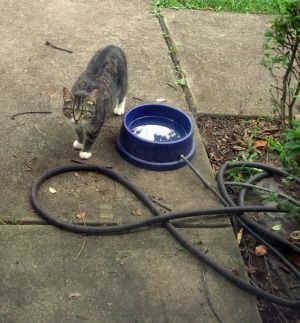
A Water Source
Whether it’s summer or winter, your pets need access to fresh water. Unless you live in a warm climate, you will either have to replace your pet’s water often as it freezes, or take steps to keep their water from freezing. In the winter I simply run an outdoor extension cord to where my feral cat station sits, and I plug in a heated pet dish. Even on the coldest days it provides a welcome source of unfrozen water for the cats, as well as the other critters in my backyard habitat. If you do not provide a source of unfrozen water for your outside pets or any strays you may care for, they are more likely to drink out of puddles or gutters, which unfortunately can be polluted with things like oil, run off from chemical deicers, and even antifreeze.
Arthritis and pets outdoors
If you happen to suffer from arthritis, you know that the cold can be particularly troublesome. Our furry family members are no different. Dogs and cats with arthritis also suffer from stiff and tender joints when it’s cold. They may seem a bit awkward when they walk, and may find it more painful and difficult to climb steps or get up onto furniture. You can make it easier for them by something as simple as placing a small step stool or set of pet steps next to their favorite chair or next to your bed if they share it with you. Providing them with a soft, thick bed in a warm area is beneficial on those cold winter nights.
It’s important to be especially gentle with arthritic pets when it’s cold. Be careful to stay close behind them when they are climbing stairs or jumping onto furniture in case they stumble and fall. Also, be careful when you take them outside for a walk, since they can be badly injured from a fall on the ice. And, whether your pet is young or old, healthy or with some medical issues, when they do come in from the outside, take a few moments to dry them off and to thoroughly clean their legs and paws, especially between the toes. Rock salt, ice, and chemical ice melt can stick to their paw pads and between their toes.
Frostbite and hypothermia
Even if you think you have taken adequate precautions, you still should be alert for the two serious conditions that are caused by exposure to the cold: frostbite and hypothermia. As with a person, when an animal is suffering from frostbite, their body gets cold and the blood is drawn away from their extremities to their central body and vital organs. Without enough blood remaining in the exposed extremities, i.e. their ears, paws, tail, nose, and genitals, those areas of the body can get cold enough that ice crystals actually form in the tissue, causing tissue damage and, in severe cases, tissue death.
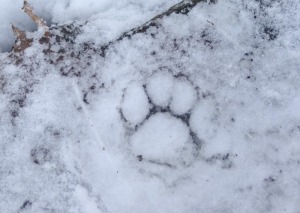
While frostbite generally affects the exposed extremities, hypothermia is a condition in which the animal’s core body temperature drops to four or more degrees below normal. Animals suffering from hypothermia are at great risk for frostbite as well due to the action of the body in funneling blood away from the extremities to the internal organs. And, since the tissue damage resulting from frostbite may actually take a few days to become evident, prevention and prompt intervention is all the more important.
One of the first signs that your pet may be suffering from a cold injury is shivering, which is basically a defense mechanism of the body to try and increase the metabolism and help to retain heat.
Other signs include slow, shallow breathing and a decreased heart rate. As the condition progresses, the animal becomes lethargic, and even shivering stops. Areas of the skin with frostbite may be swollen, red, hard, and painful. And, the gums may be pale or even bluish in color. If your pet is showing any signs of a cold injury, it is critical that they be moved into a warm area as quickly as possible and, if wet, that they be dried off. A hair dryer can be used to dry wet fur, just be very careful to keep it at a safe distance to avoid burns. Wrap them in warm towels or blankets. Warming the towels or blankets in the dryer can help, but again you must be careful that they are not too hot. Likewise, a hot water bottle can be used, but it’s best to wrap it in a towel and place it next to, not directly on, the animal. If the animal is conscious and alert enough to safely drink something, you can give them some warm liquid, such as broth. Be careful not to massage or rub the animal’s skin, as that will be painful and, in the case of frostbite, can cause further tissue damage.
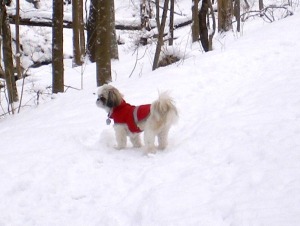
And, even if your pet appears to respond well to your care, it is advisable that they been seen by a veterinarian, since the full extent of the injury may not be apparent, and frostbite and hypothermia may well require treatment beyond what you can do yourself.
Just be careful
The winter season is a beautiful time of the year. With just some common sense precautions, you can help to ensure that your pets will be able to enjoy it as much as you do.
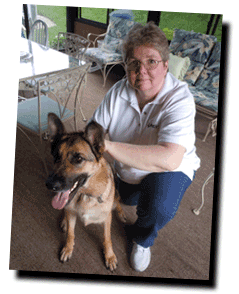
About Karen Sable
Karen Sable, owner of Pet Emergency Training, LLC, completed the Pet Tech Instructor program in March, 2011 and teaches pet first aid classes in the Pittsburgh area. Karen is a trained responder with several national animal response/rescue teams, including American Humane’s Red Star Animal Emergency Services Team, United Animal Nations’ Emergency Animal Rescue Service, and Noah’s Wish Disaster Response Team. She is also a member of the PA/Allegheny County Animal Response Team, and a volunteer animal rescue transporter.
In addition to having a Veterinary Assistant diploma, Karen’s training certifications include Emergency Animal Sheltering, Large Animal Rescue, Animals in Disaster, Livestock in Disaster, Hazardous Materials, Incident Command and National Incident Management. As a former healthcare Human Resources Director, Karen now devotes her extensive training experience, and love of animals, to teaching pet care professionals and fellow pet parents the skills and knowledge that can save their pets and improve the quality of their pets’ lives. Visit her website at Pet Emergency Training, LLC.
Karen has written a series of guest posts for The Creative Cat covering pet first aid, wellness and disaster rescue. Read Karen’s other articles and Read more about Karen in The Creative Cat Welcomes Guest Columnist Karen Sable.

